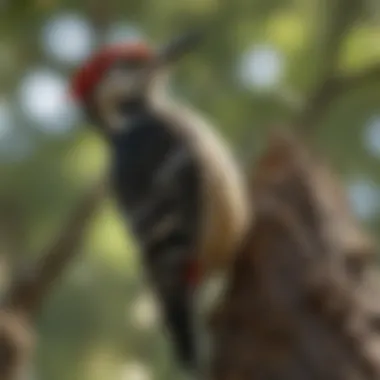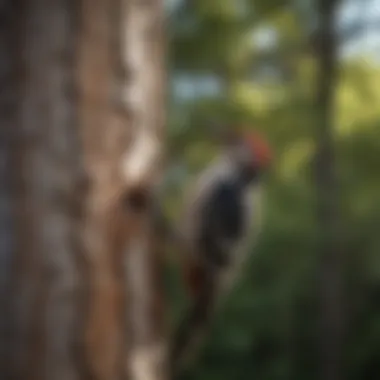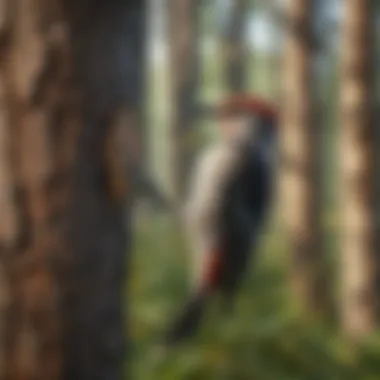Effective Woodpecker Repellents at Lowe's


Intro
Woodpeckers are often seen as charming birds in their natural habitat, yet their behavior can lead to significant problems for homeowners. Pecking at wooden structures, these creatures are not just a nuisance; they can cause severe damage to homes, fences, and trees. This situation prompts an exploration into the efficacy of repellents designed to deter these birds, particularly those available at Lowe's. Understanding the underlying principles of woodpecker repellents is vital not only to protect property but also to foster respect for these fascinating creatures.
In this comprehensive guide, we will tackle various aspects of woodpecker deterrents. We'll start with a solid understanding of what pests are and how identifying these unwelcome guests plays a pivotal role in pest control. Next, we'll dive into practical prevention techniques, sharing home and garden methods that can help homeowners ward off woodpecker activity. Finally, we’ll explore eco-friendly pest control solutions. Throughout, we aim to present a balanced view that acknowledges the ecological role of woodpeckers while equipping homeowners with practical tools to manage any potential conflicts.
Preamble to Woodpecker Infestations
When it comes to dealing with wildlife encroachments, woodpeckers are often overlooked, yet they can pack quite a punch when it comes to property damage. Understanding woodpecker infestations is crucial for homeowners who cherish their peace of mind, as these birds can wreak havoc on siding, roofs, and other wooden structures. With the right knowledge, individuals can effectively navigate this perplexing issue, ensuring their homes remain intact while considering the ecological role these birds play.
Understanding Woodpecker Behavior
Woodpeckers are not simply pests; they are fascinating creatures with specific behaviors that drive their activities. These birds are typically drawn to places where they can find food, as insects hidden within wood are a delicacy for them. It’s important for homeowners to recognize that woodpeckers are usually not targeting our homes out of malice but rather out of instinct.
Their drumming is not only a form of communication but also a method to establish territory. In springtime, male woodpeckers engage in loud drumming to attract females, often targeting resonant surfaces like gutters or wooden siding. This means, if you hear an incessant pecking sound, it's a good chance it's related to their mating rituals rather than simply destruction. Furthermore, when they start to carve cavities into wood, it’s often a sign they’ve found a suitable spot for nesting or feeding.
Signs of Woodpecker Damage
It's essential for homeowners to be vigilant and proactive when it comes to identifying signs of woodpecker damage. Ignoring small signs can lead to bigger issues down the line.
Some common indications include:
- Holes or Cavities: Look for small holes, which are often about the size of a quarter or smaller. These can be entry points for insects.
- Chips and Scales: Notice any chipped wood or scales on the surface; this can signify that woodpeckers are foraging for food.
- Drumming Marks: Repeated drumming can also leave small indentations, which may not be visible from a distance but are easily noticeable upon closer inspection.
- Scratches: Vertical scratches on wood may come from the woodpecker’s beak or claws. These marks can harm the aesthetic appeal of your home.
"Early detection of woodpecker damage can save you both time and money in repairs."
By understanding their behaviors and recognizing the signs of damage, homeowners can take timely action to mitigate the risks associated with woodpeckers. Engaging in preventative measures is not only about safeguarding your property but also about fostering a respectful relationship with local wildlife.
The Role of Repellents
Understanding the role of repellents in managing woodpecker issues is crucial for homeowners facing challenges with these birds. Repellents serve as a first line of defense, helping to protect one’s property while maintaining a balance with nature. They aim to deter woodpeckers from damaging structures while also appreciating the ecological benefits the birds provide. This section provides insights into how various repellents function, their types, and considerations to keep in mind when choosing the right approach for your needs.
How Repellents Work
Repellents function based on altering the environment in a way that is uninviting to woodpeckers. Unlike pesticides, which can eliminate pests, repellents work on the premise of prevention. They can create an uncomfortable atmosphere by using natural deterrents or sensory triggers that make the area less appealing. The effectiveness of these products often hinges on understanding woodpecker behavior, as these birds can be quite persistent.
When applied correctly, repellents can reduce the likelihood of woodpecker visits. However, it’s essential to use them consistently, as effectiveness can diminish over time if the birds become accustomed to the solutions being used.
Types of Woodpecker Repellents
There are several categories of woodpecker repellents, each with different approaches and mechanisms. Identifying which type suits your situation best is vital.


Sound-based Repellents
Sound-based repellents utilize high-frequency noises or irritating sounds to dissuade woodpeckers from approaching a particular area. These sounds can mimic predators or be specially designed to be bothersome to birds. One of the chief characteristics of sound-based options is their non-invasiveness—they deter without causing harm.
While popular among some homeowners, these repellents can have drawbacks. For instance, they may not be effective at all times or may require regular adjustments to maintain efficacy. As these birds might adapt to recurring noises, it’s wise to rotate sounds or combine with other methods for better results.
Scent-based Repellents
Scent-based repellents contain natural or synthetic odors that are unpleasant to woodpeckers. Common examples include strong-smelling substances like peppermint oil or commercial formulas designed specifically for pest control. The key aspect here is their ability to create a strong olfactory barrier.
While scent repellents are beneficial due to their ease of application, their effectiveness can be hit or miss. Environmental factors like rain or wind may dilute scents, necessitating reapplication. Still, they provide an excellent option for a chemical-free approach to keeping woodpeckers at bay.
Visual Repellents
Visual repellents incorporate flashy objects, reflective materials, or decoys that can frighten woodpeckers away. Items like aluminum foil strips, wind spinners, or even owl decoys take advantage of a woodpecker's instinct to steer clear of potential threats. Their visual presence creates an unpredictable environment for these birds.
While generally low-cost and simple to install, visual repellents may require frequent changes in placement to maintain effectiveness, as woodpeckers can grow accustomed to what they see over time. Combining visual approaches with other types of repellents often yields the best results, ensuring a more comprehensive deterrence strategy.
Woodpecker control is certainly a nuanced subject, deserving of careful consideration and action. Choosing the right kind of repellent can mean the difference between a harmonious living situation with nature and repeated headaches caused by unsightly damage. Understanding these tools empowers homeowners to take proactive steps in maintaining their properties.
Lowe's Woodpecker Repellent Products
Understanding the offerings at Lowe's regarding woodpecker repellents is vital for homeowners grappling with these unique avian visitors. The availability of effective products can significantly improve one's chances of protecting property from damage while remaining conscious of the ecological significance of woodpeckers. These birds, while beautiful and beneficial in many ways, can pose a threat to wooden structures such as siding, decks, and eaves. Thus, exploring the options Lowe's provides not only tackles immediate concerns but also offers long-term solutions that can keep these pesky birds at bay effectively.
Overview of Available Products
When browsing through the aisles of Lowe's, you might find a variety of woodpecker repellent products. These range from sound devices that mimic the calls of predators to visual deterrents that play tricks on the eyes of our feathered friends. Some common categories include:
- Ultrasonic Repellents: These gadgets emit high-frequency sounds that are typically inaudible to humans but irritating to woodpeckers, pushing them away from your home.
- Scare Tape: Shiny and reflective, scare tape moves with the wind, creating visual disturbances that are meant to frighten birds away.
- Bird Spikes: Installed along areas where woodpeckers like to perch, these spikes reduce landing spots, making it less inviting for them.
- Scent Repellents: Some products claim that strong odors, such as peppermint oil, can deter woodpeckers, although this method may be more hit or miss compared to others.
Each of these options comes with unique benefits, and the choice often depends on the particular situation you're facing regarding woodpecker activity.
Analyzing Effectiveness
While it's easy to assume that any woodpecker repellent will work as intended, effectiveness can vary based on several factors: the product's quality, the type of woodpecker, and the specific environment. A sound-based device might work wonders in one yard but fall flat in another due to surrounding noises or other distractions. Likewise, what might deter a yellow-bellied sapsucker could be of little concern to a downy woodpecker.
Moreover, many users report mixed results when using visual deterrents. For instance, scare tape can be effective during the day when there is sufficient sunlight, but its effectiveness decreases at night. For a homeowner, understanding these subtleties can make all the difference in selecting the right solution for their particular situation. Factors to consider include:
- Placement: How and where the product is installed can greatly impact its effectiveness.
- Duration of Use: Sometimes, persistent application is required before you see results, as birds may initially be cautious.
- Feedback from Others: Local insights from your community may provide clues about what works best in your area.
User Reviews and Feedback
What truly shines a light on the efficacy of any product? The voices of those who have actually used them. Before making a purchase, diving into user reviews can offer a wealth of information. Many products in Lowe's inventory come equipped with feedback from past customers, which can help prospective buyers determine the utility of what they're considering.


Some customers have noted:
- Positive Experiences: "The ultrasonic repellent worked like a charm! After a week, I barely saw any woodpecker activity."
- Mixed Feedback: "Scare tape looked awesome but didn't completely stop the woodpeckers. They seemed to get used to it over time."
- Surprising Outcomes: "I thought the scent repellent would be ineffective, but it actually seems to have worked better than expected!"
Collectively, this feedback serves as a critical compass for homeowners navigating their woodpecker woes. It's worth mentioning that some of these reviews can be found on platforms like reddit.com or directly on Lowe's official site as well as consumer feedback forums.
"Understanding customer experiences can provide insights far beyond the manufacturer’s claims, revealing practical realities about product performance."
Arming yourself with this knowledge will lead to more informed decisions. Coupled with a deeper understanding of the products available at Lowe's, and you’ll be well on your way to finding a solution that not only protects your home but also respects the environment.
Ecological Considerations
Understanding the delicate balance between pest control and ecological conservation is crucial when addressing woodpecker issues. While it’s natural for homeowners to seek relief from woodpecker damage, it's equally important to recognize the inherent value these birds bring to our environment. It’s not just about repelling; it’s about harmonizing with nature’s cycles and acknowledging the roles these creatures play in their ecosystems.
The Importance of Woodpeckers
Woodpeckers are not merely an inconvenience; they are integral to the health of forests and gardens. They play a vital role in controlling insect populations, making them natural allies for homeowners. Their probing beaks help them locate larvae and insects hiding beneath the bark of trees. This behavior ultimately contributes to the control of pest species that might otherwise overwhelm other wildlife or plant life. Homeowners might notice a reduced insect load in areas frequented by woodpeckers, leading to a healthier living space for other species and plants.
Moreover, when woodpeckers drill into trees, they create cavities that are eventually used by other birds, mammals, and insects as homes. This nesting behavior increases biodiversity, enhancing the local ecosystem. One might say, a woodpecker's drumming is not just a nuisance – it’s a heartbeat of a thriving habitat.
Balancing Pest Control and Conservation
Finding the right approach to pest management requires a thoughtful, balanced perspective. While it’s essential to safeguard your property, it’s also pivotal to consider the broader implications of our actions.
- Integrated Pest Management (IPM): Instead of relying solely on chemical repellents, homeowners should explore integrated pest management techniques. This approach combines practical strategies with ecological understanding, ensuring that interventions do not harm beneficial species.
- Use of Non-lethal Repellents: Many homeowners achieve satisfactory results by employing sound, visual, or scent-based deterrents that do not kill or harm woodpeckers. This reflects a commitment to preserving wildlife while addressing property concerns.
- Creating Wildlife-Friendly Spaces: Encouraging environments that support other wildlife can naturally deter woodpeckers. For instance, planting native flowers and shrubs can attract natural predators, which helps to balance the local ecosystem and discourage woodpeckers from making your home their target.
In summary, the crux of effective woodpecker management lies in revisiting our methods and considering the ecological footprint of our choices. By adopting a holistic view of pest management, homeowners can find solutions that protect their property while also ensuring the continuity of the critical relationships within our ecosystems.
Preventive Measures for Homeowners
When discussing woodpecker issues, homeowners often find themselves at a crossroads, balancing the need for protection against these birds with the importance of preserving ecological balance. Preventive measures play a vital role in this approach, acting as the first line of defense before considering repellents or other remedial actions. By understanding how to deter woodpeckers proactively, homeowners can avoid extensive damage, reduce repair costs, and contribute positively to their local environment.
Identifying Attractants
Understanding what draws woodpeckers to your property is crucial for prevention. One of the main attractants is the presence of insects, especially those that live under wood surfaces, like termites or carpenter ants. Homeowners should routinely inspect wooden structures, including decks and siding, for signs of insect activity. Another factor is food availability; woodpeckers are primarily drawn to suet, seeds, and berries. By eliminating these food sources or feeding designs that limit access, such as using squirrel-proof bird feeders, homeowners can diminish interest from woodpeckers and prevent potential infestations.
Physical Barriers and Modifications
When attractants are limited, the next step is implementing physical barriers. These modifications can serve as effective deterrents without harming the birds.
Netting and Screens
Using netting and screens is a straightforward method to protect vulnerable areas without discouraging birds from their natural habitats. These barriers serve a fundamental purpose: they create a physical block that woodpeckers can't navigate. The key characteristic of netting is its ability to cover large areas, such as siding or eaves, without being overly invasive. One unique feature is the range of materials available—durable, yet lightweight options can easily blend with your home’s exterior, making them a popular choice. However, it's essential to ensure the netting is securely affixed, as wind can dislodge loose materials. The primary advantage lies in its effectiveness against persistent pecking while allowing the home to maintain its aesthetic appeal.


Siding Choices
Changing siding materials may also present a solution for homeowners. Certain types of siding, like vinyl or metal, can deter woodpeckers because they lack the soft, inviting texture found in wood products. The main reason siding is considered a beneficial choice is its durability and resistance to pecking. New types of composite siding materials have been engineered to mimic wood's appearance while providing a harder surface that is less appealing to woodpeckers. A unique feature here is the variety of textures available in these materials, allowing them to fit in seamlessly with different architectural styles. However, while siding modifications can be effective, they often require significant investment and may not address existing infestations.
"Preventing woodpecker damage is more about creating an environment that is less appealing than it is about pushing them out entirely. They are an essential part of our ecosystem, even if they can be a nuisance sometimes.”
By addressing attractants and utilizing physical barriers, homeowners can effectively shift the odds in their favor, reducing the chances of woodpecker-related damage while fostering a respectful relationship with nature.
Alternative Deterrent Solutions
When grappling with woodpecker issues, exploring alternative deterrent solutions is key. These methods, aside from the commercial repellents available at places like Lowe's, offer diverse ways to manage and control woodpecker activity. They emphasize natural and eco-friendly approaches, appeal to homeowners interested in maintaining their gardens and properties while playing fair with nature, and consider the unique behaviors of woodpeckers.
In the realm of pest management, using alternatives can minimize reliance on synthetic substances, which may be beneficial for the environment and ecosystems surrounding our homes. Here are two effective alternatives that homeowners can employ:
DIY Repelling Techniques
This approach encompasses various hands-on solutions that are not only cost-effective but also allow a direct, personal touch in addressing woodpecker concerns. Here are notable DIY techniques:
- Reflective Surfaces: Hanging aluminum foil strips, old CDs, or reflective tape around areas where woodpeckers frequent can deter these birds. The sunlight bouncing off these surfaces creates an unsettling experience for the woodpeckers, prompting them to look elsewhere.
- Noise Makers: Utilizing wind chimes or creating noise with rattling items can be a practical deterrent. Woodpeckers are generally sensitive to sudden noises, so creating an unexpected atmosphere might nudge them away from your property.
- Homemade Sprays: Mixing water with natural ingredients like vinegar, peppermint oil, or cayenne pepper in a spray bottle can serve as a potent repellent. Spraying this solution on areas affected by woodpecker activity may help in discouraging them from returning.
"Creative solutions often yield great results, turning your frustrations into successes without breaking the bank."
Using Natural Predators
Integrating natural predators into your yard can serve as an ecological balance and an effective deterrent. Maintaining a healthy ecosystem not only helps with woodpecker issues but encourages biodiversity in your neighborhood. Consider the following:
- Installing Owl Decoys: Owls are known predators of woodpeckers. Placing decoys to mimic owls can alert woodpeckers of potential danger, thereby encouraging them to relocate.
- Encouraging Hawks: If you have a large enough garden, fostering an environment for hawks may deter woodpeckers. These majestic birds hunt smaller prey and contribute to keeping woodpecker populations in check naturally.
- Maintaining Bird-Friendly Habitats: Planting certain shrubs or trees that attract natural predators, like blue jays, might help. Blue jays, while not direct hunters of woodpeckers, can sometimes scare them off due to their territorial nature.
Finale and Recommendations
As we bring this discussion to a close, it’s essential to reflect on the key ideas surrounding woodpecker management and the various methods available for homeowners. Understanding the role of repellents, both conventional and alternative, can transform the approach homeowners take towards these avian visitors. The aim isn’t solely to deter woodpeckers but to do so in a way that is ecologically respectful and effective.
Evaluating Your Options
Sifting through the choices when it comes to woodpecker repellents can be a bit like navigating a minefield. It's crucial to evaluate each option on the basis of effectiveness, safety, and convenience. Options can be broken down as follows:
- Commercial Products: Many homeowners turn to what they can find at Lowe's. While some products tout being effective against woodpeckers, it's good practice to look for user testimonials and research independent reviews. You might also discover surprising insights from places like Reddit or Facebook.
- DIY Solutions: Some people swear by homemade remedies. For example, a mixture of vinegar and water can act as a repellent. Others have found success using reflective surfaces like old CDs or aluminum foil, which can unsettle the birds and keep them at bay.
- Natural Techniques: Incorporating natural predators, such as installing a perch for hawks nearby, is another method to consider. This could encourage a more natural balance, deterring woodpeckers without undue disruption.
In considering these options, think carefully about effectiveness based on your specific situation. Often, a combination of approaches yields the best results.
Long-term Management Strategies
In the grand scheme of home maintenance, it's critical to adopt long-term strategies for managing woodpecker populations. Here are some strategies to ponder:
- Habitat Modification: Ensuring that your home doesn't present an appealing environment for woodpeckers can help over time. This includes sealing potential nesting sites and removing any food sources.
- Regular Monitoring: Keeping an eye on your property for signs of woodpecker activity can allow you to react before any serious damage occurs. Early detection can often mean less stressful management.
- Test and Adapt: What works for one homeowner may not work for another. Implement a system of trial and error with both conventional and alternative methods. Observe what seems to work, and be prepared to pivot if results are underwhelming.
Effective management of woodpecker issues requires a blend of efficiency with a touch of creativity. A thoughtful approach ensures we respect the ecological role these birds play while minimizing their impact on our homes.
Combining these methods into your strategy can not only address existing issues but help prevent future ones. It’s all about finding the right balance between protecting your home and respecting the environment. With a bit of planning and effort, homeowners can tackle woodpecker concerns head-on.



